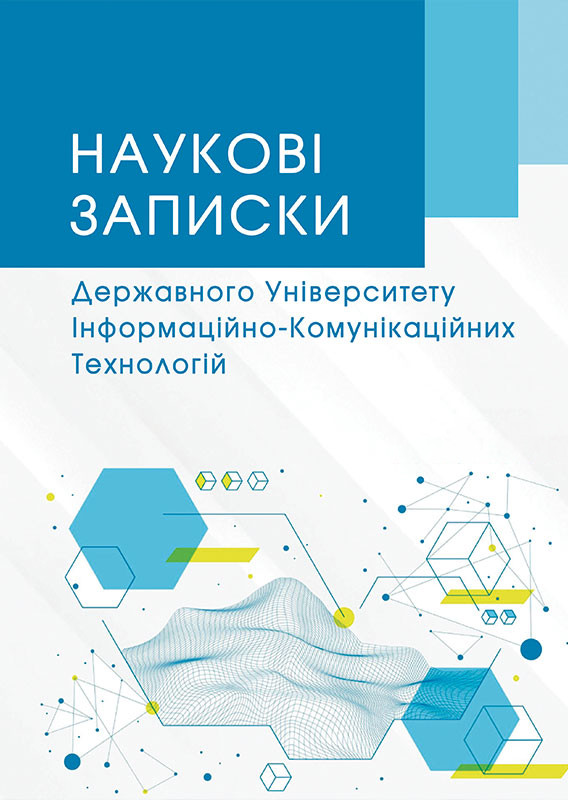ТОПОЛОГІЧНИЙ ПІДХІД ДО ВЕКТОРИЗАЦІЇ РАСТРОВОЇ ГРАФІКИ НА ОСНОВІ СИМПЛИЦІАЛЬНИХ КОМПЛЕКСІВ
DOI: 10.31673/2786-8362.2025.017724
Анотація
У статті розглядається топологічний підхід до векторизації
растрової графіки з використанням методів симплиціальних комплексів та пошуку сталих
гомологій. Основну увагу зосереджено на розробці алгоритму побудови симплиціальних
комплексів – ефективного інструменту для виявлення структурних та просторових характеристик
зображення. Досліджено властивості симплиціальних комплексів у контексті сегментації
піксельних даних та розроблено алгоритм формування топологічних структур на основі пікселів
растрового зображення. Запропоновано алгоритм пошуку сталих гомологій. Запропонований підхід
дозволяє ефективно аналізувати топологічні зв’язки між пікселями, виокремлювати значущі
компоненти та підвищити точність сегментації зображень. Перспективність результатів полягає в
покращенні якості векторизації, особливо у випадках складної геометрії, структурної
неоднорідності та наявності шуму в даних.
Ключові слова: векторизація зображень, симплиціальні комплекси, топологічний аналіз
даних, сегментація зображень, кластеризація, растрова графіка, TDA, топологічні методи, метод
сталих гомологій, комплекс Вієторіса-Ріпа
Список використаної літератури
1. Zomorodian, A., & Carlsson, G. (2005). Computing persistent homology. Discrete &
Computational Geometry, 33(2), 249–274. URL: https://doi.org/10.1007/s00454-004-1146-
yOUCI+3ResearchGate+3OUCI+3.
2. Edelsbrunner, H., Letscher, D., & Zomorodian, A. (2002). Topological persistence and
simplification. Discrete & Computational Geometry, 28(4), 511–533. URL:
https://doi.org/10.1007/s00454-002-2885-2.
3. Zomorodian, A. (2010). Fast construction of the Vietoris-Rips complex. Computers &
Graphics, 34(3), 263–271. URL: https://doi.org/10.1016/j.cag.2010.03.007.
4. Munch, E. (2017). A user’s guide to topological data analysis. Journal of Learning Analytics,
4(2), 47–61. URL: https://doi.org/10.18608/jla.2017.42.6.
5. Tausz, A., & Carlsson, G. (2011). Homological coordinatization. arXiv. URL:
https://arxiv.org/abs/1107.0511arXiv.
6. Carlsson, G. (2009). Topology and data. Bulletin of the American Mathematical Society,
46(2), 255–308. URL: https://doi.org/10.1090/S0273-0979-09-01249-X.
7. Yang, Z., Sun, Y., Liu, S., Shen, C., Jia, J. (2020). Dense RepPoints: Representing visual
objects with dense point sets. In A. Vedaldi, H. Bischof, T. Brox, & J. M. Frahm (Eds.), Computer
Vision – ECCV 2020 (Vol. 12366, pp. 226–242). Springer. URL: https://doi.org/10.1007/978-3-030-
58589-1_14.
8. Roussel, J.-R., Bourdon, J.-F., Morley, I. D., Coops, N. C., Achim, A. (2023). Vectorial and
topologically valid segmentation of forestry road networks from ALS data. International Journal of
Applied Earth Observation and Geoinformation, 118, 103267. URL:
https://doi.org/10.1016/j.jag.2023.103267.
9. Edelsbrunner, H., & Harer, J. (2010). Computational topology: An introduction. American
Mathematical Society.
10. Carlsson, G., & Vejdemo-Johansson, M. (2021). Topological data analysis with applications
(1st ed.). Cambridge University Press. URL: https://doi.org/10.1017/9781108975704.
11. Yesilli, M. C., & Khasawneh, F. A. (2021). Data-driven and automatic surface texture
analysis using persistent homology. In 2021 20th IEEE International Conference on Machine
Learning and Applications (ICMLA) (pp. 1350–1356). IEEE. URL:
https://doi.org/10.1109/ICMLA52953.2021.00219.
12. Corcoran, P., & Jones, C. B. (2023). Topological data analysis for geographical information
science using persistent homology. International Journal of Geographical Information Science,
37(3), 712–745. URL: https://doi.org/10.1080/13658816.2022.2155654.
13. Snášel, V., Nowaková, J., Xhafa, F., & Barolli, L. (2017). Geometrical and topological
approaches to big data. Future Generation Computer Systems, 67, 286–296. URL:
https://doi.org/10.1016/j.future.2016.06.005(upcommons.upc.edu).
14. Юрчук, І. А. (2014). Метод сталих гомологій топологічного аналізу даних. Наукоємні
технології, (3)23, 289. URL: https://jrnl.nau.edu.ua/index.php/SBT/article/view/7397/8431.
15. De Silva, V., Morozov, D., & Vejdemo-Johansson, M. (2011). Dualities in persistent
(co)homology. Inverse Problems, 27(12), 124003. URL: https://doi.org/10.1088/0266-
5611/27/12/124003.
16. Edelsbrunner, H., & Harer, J. (2010). Computational topology: An introduction. American
Mathematical Society.
17. Carlsson, G., & Vejdemo-Johansson, M. (2021). Topological data analysis with applications
(1st ed.). Cambridge University Press. URL: https://doi.org/10.1017/9781108975704.
18. Snášel, V., Nowaková, J., Xhafa, F., & Barolli, L. (2017). Geometrical and topological
approaches to big data. Future Generation Computer Systems, 67, 286–296. URL:
https://doi.org/10.1016/j.future.2016.06.005(upcommons.upc.edu).
19. Huber, S. (2021). Persistent homology in data science. In P. Haber, T. Lampoltshammer, M.
Mayr, & K. Plankensteiner (Eds.), Data Science – Analytics and Applications (pp. 81–88). Springer
Fachmedien Wiesbaden. URL: https://doi.org/10.1007/978-3-658-32182-6_13(OUCI).
20. Wong, C.-C., & Vong, C.-M. (2021). Persistent homology based graph convolution network
for fine-grained 3D shape segmentation. In Proceedings of the IEEE/CVF International Conference
on Computer Vision (ICCV), IEEE. URL:
https://doi.org/10.1109/ICCV48922.2021.00701(ResearchGate).
21. Lum, P. Y., Singh, G., Lehman, A., Ishkanov, T., Vejdemo-Johansson, M., Alagappan, M.,
Carlsson, J., & Carlsson, G. (2013). Extracting insights from the shape of complex data using
topology. Scientific Reports, 3, p. 1236. URL: https://doi.org/10.1038/srep01236.
22. van Veen, H. J., Saul, N., Eargle, D., & Mangham, S. W. (2019). Kepler Mapper: A flexible
Python implementation of the Mapper algorithm. Journal of Open Source Software, 4(42), 1315.
URL: https://doi.org/10.21105/joss.01315(joss.theoj.org).
23. Otter, N., Porter, M. A., Tillmann, U., Grindrod, P., & Harrington, H. A. (2017). A roadmap
for the computation of persistent homology. EPJ Data Science, 6, 17. URL:
https://doi.org/10.1140/epjds/s13688-017-0109-5(SpringerOpen).

